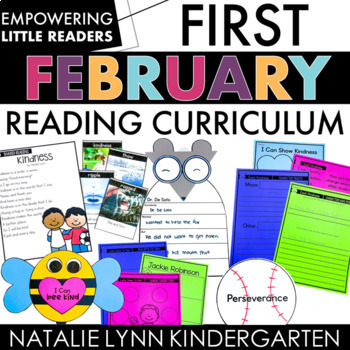1st Grade February Interactive Read Aloud Lessons | Empowering Little Readers
- Zip
Also included in
- FLASH SALE through Memorial Day only! First grade teachers, are you looking for something to make planning for your whole group literacy block or Reader's Workshop time easy and fun? These 1st grade interactive read aloud units contain everything you need to teach foundational skills, phonemic awarePrice $25.00Original Price $100.00Save $75.00
Description
First grade teachers, are you looking for something to make planning for your literacy block or Reader's Workshop time easy and fun? This Empowering Little Readers First Grade February reading unit contains everything you need to teach foundational skills, comprehension, story elements, shared reading, grammar, and vocabulary with February interactive read alouds for 1st Grade.
This unit uses 1st grade interactive read alouds with a close read model - each week you will focus on one book and going deeper within that text.
*This is available in a yearlong bundle here: Empowering Little Readers 1st Grade Reading Curriculum
Each week contains 5 days worth of lesson plans for you with foundational or phonemic awareness activities, shared reading (poetry), a whole group reading lesson, independent work, vocabulary, crafts, and directed drawings.
What is included in each unit?
- Interactive Read Aloud Lessons for February
- Comprehension Strategies and Printables
- Poems for Shared Reading
- Mentor Sentences with Grammar Mini-Lessons
- Weekly Vocabulary
- Phonological and Phonemic Awareness
- Weekly Crafts
- Weekly Directed Drawings
- Posters and Anchor Charts
February Interactive Read Aloud Books:
[These books are NOT included. You will need to purchase separately.]
- Each Kindness - Jaqueline Woodson
- Love Is My Favorite Thing - Emma Chichester Clark
- Luke Goes To Bat - Rachel Isadora
- Dr. De Soto - William Steig
Comprehension Focus for the February Interactive Read Alouds:
Each Kindness
Theme: Kindness
→ Students will use text evidence to determine character feelings and character traits. Nonfiction text: We Can Show Kindness
Love Is My Favorite Thing
Theme: Love
→ Students will make predictions, use text evidence to determine character feelings, and make connections.
Nonfiction text: Taking Care of Pets
Luke Goes To Bat
Theme: Perseverance
→ Students will identify character traits, infer, and make connections.
Nonfiction text: Jackie Robinson
Dr. De Soto
Theme: Dental Health
→ Students will practice summarizing, inferring, and asking and answering questions.
Nonfiction text: Dental Health
February Phonological and Phonemic Awareness Focus: Segmenting and blending words, Manipulating sounds in words
February Grammar for 1st Grade:
- Shades of meaning
- Antonyms
- Possessive pronouns his, her, their
- Suffix -ed
FREQUENTLY ASKED QUESTIONS
What are the benefits to using 1st grade interactive read aloud lessons in your classroom? Interactive read alouds give your read alouds purpose! They allow you to meet standards in an engaging way while using February picture books as mentor texts to teach 1st grade comprehension strategies. They also give students a connection to new vocabulary words.
These books seem too hard for my 1st grade students! You, the teacher, will be reading these books to students whole group. They will be working on comprehension strategies while listening to the story. These February interactive read alouds will not take the place of your phonics instruction or small group reading instruction.
How would you suggest fitting these interactive read alouds into my ELA block? These 1st grade interactive read alouds would take place during your whole group reading curriculum (classroom read alouds). This might look like:
- Phonemic Awareness Mini Lesson - 5 minutes
- Shared Reading - 5 minutes
- Empowering Little Readers Lesson - 20 minutes
- Students complete independent practice from the lesson (this is their ticket to centers) - 5 minutes
- Literacy Centers and Small Group Reading - NOT in this curriculum
- Phonics Lesson and Practice - NOT in this curriculum
- Vocabulary Mini Lesson - 5 minutes
- Mentor Sentence and Grammar Mini Lesson - 5-10 minutes
What are the benefits to using mentor sentences in 1st grade? Mentor sentences allow first grade students to work on concepts of print, fluency and reading with expression, and grammar skills while relating to their read aloud.
Do these 1st grade reading units include comprehension tests or assessments? Yes, there is a comprehension check quiz about the text at the end of the week. This assessment is optional.
What do the first grade vocabulary lessons look like? The 1st grade vocabulary lessons are short mini lessons. Each week will focus on 4 vocabulary words that come from the interactive read aloud, which will give students a connection to the words. Students will learn the vocabulary words with hand motions, define and illustrate the vocabulary words, relate the vocabulary words to their own experiences, and use the vocabulary words in sentences.
What does shared reading look like in 1st grade? Shared reading is first grade poetry. All 1st grade poems included in these units are original poems written by me! Each day, you will read the February poems for 1st grade together for fluency. Students will receive their own poems to put in a poetry folder or notebook. They will also receive a paper poem book for each poem.
What do the 1st grade phonological and phonemic awareness lessons look like? These are quick, teacher-directed phonological and phonemic awareness mini lessons. They are scripted for you.
Questions? Email me at natalielynnkindergarten@gmail.com






